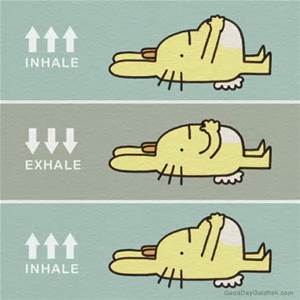Why Your Belly Matters
When I was going through a time of extreme anxiety in my life, I was taught how to breathe. I mean really breathe. Deep belly breathing, also known as diaphragmatic breathing.
At that time in my life, I would have tried anything to ease my panic attacks and my general anxiety that had adrenalin coursing through my body like wildfire. It felt like, at any minute, something catastrophic would happen. The breathing helped. It cooled the fire. It always helps.
What I notice is that deep belly breathing is not something that we’re used to, and this form of breathing–what the body has to do to accomplish this–is the opposite of what many women are comfortable doing. Now, I want you to take a second and notice your belly. Is it relaxed? Are you holding it in? Are you sucking it in? You may not have even realized until I asked you to pay attention that you’re holding your belly taut. If not, pat your self on the belly, that’s great!
The belly is such a source of body image shame, I believe we have become conditioned to hold it in, whether we are aware of this, or not. “Muffin top”, “menopot”, “paunch”, even the word “belly” itself can have negative connotations.
And the message that we get about the stomach and our health is ever-present: Your waist measurements should not exceed ## inches or else… That message instills panic, not curiosity about our health and well-being. There are methods to shrink the belly that are ripe for the picking: Crazy masochistic corsets, supplements, diets, restriction of specific foods, and surgery, to name a few.
The belly seems to be the common denominator in the mathematical equation of body fractions, or how we fragment, objectify, and judge the body.
All roads lead to belly shame here, right? So the natural thing would be to hold it in. Don’t let anyone see that belly until you make it flat and toned! Suck it in for the photos, hold it in during your date, keep it undercover, do 500 more crunches…
*And let me make note here that engaging your core is not the same as holding in your stomach! I swear.
Here’s the thing–
When we hold in the belly, we are probably not getting the breath we need. Most likely, the breath is shallow, not generous and flowing naturally. And if you’re holding in the belly, you may also be contracting other muscles.
Symbolically, holding in the belly is like contracting center of your being, and that’s as uncomfortable emotionally, as physically. What else might you be holding that you need to express, that needs air?
As I’m writing this, I feel the sadness for all the times I have held my belly in, just to try to achieve acceptance in our culture, to try to avoid the sometimes real and other times perceived commentary and judgments of others. It’s sad, but true that the judgment does indeed exist, so we are hard-wired to expect it and want to protect ourselves from it. We are “armed” and at the ready to make our move. “Suck it up, suck it in!” that inner critic warns. And the compliant response? To make the middle disappear, contract it into some kind of…nowhere, nothingness, non-existence.
Even at home, you might notice, for a moment that you’re relaxing the belly, sitting comfortably, delighting in some needed relaxation, or enjoying a delicious meal…and then you take notice, look down in disgust and tighten back up. Or there’s the quick mirror check—front, then side–for a complete evaluation. Even if no one else is there to “see”. It can happen so quickly, almost unnoticeable. Front-to-side-to-judgment.
Yoga has been one way for me to let go and accept. Yoga is all about the breath, so if I’m not allowing the breath, I can’t really practice yoga. I am still a novice, but I do feel the difference in my practice when I can really breathe. There is no one else at those times. Even my teacher’s voice enters, unobtrusively, gently guiding.
Author Linda Sparrowe says in the book, Yoga and Body Image, “I know when I become disconnected to my breath or when my mind goes on one of its judgmental tangents, my body feels abandoned and gets off kilter. Working with the breath, connecting it to asana or simply sitting in meditation, allows me to pause often and listen deeply. In those pauses between the inhale and exhale (especially the pause right after the exhale), sometimes everything coalesces, and in that still moment of acceptance, all negativity melts away.”
So let’s learn how to breathe, my lovelies. 
Place one hand on your abdomen (belly), right below your rib cage. Inhale slowly and deeply through your nose and imagine that your belly is a balloon that you are slowly blowing up. You should feel your hand actually rise. Your chest should move only a little while your belly expands. When you’ve taken a full breath, pause for a moment and then exhale slowly through your nose or mouth, whichever you prefer. Be sure to exhale fully.
As you exhale, allow your whole body to just let go.
Do ten slow, full belly breaths. Try to keep your breathing smooth and regular without sucking in a big breath or letting your breath out in a quick whoosh. If it helps, you can count on the inhalation—1-2-3… and then count on your exhalation, but add 2 more counts to be sure you are fully releasing your breath. (So, if you inhale for 4 counts, you will exhale for 6).
If you feel light-headed while you’re getting used to this practice, pause for minute, then start again.
Try this breathing for 5 minutes if you need to relax or you are noticing some signs of anxiety. It should help to ease your symptoms.
Of course, if you’re experiencing anxiety that doesn’t go away, please seek medical attention promptly!
Be gentle with yourself. Always. And know that you are loved.
~Sibel
For your reflection~
Where in your life do you need some breathing room?




